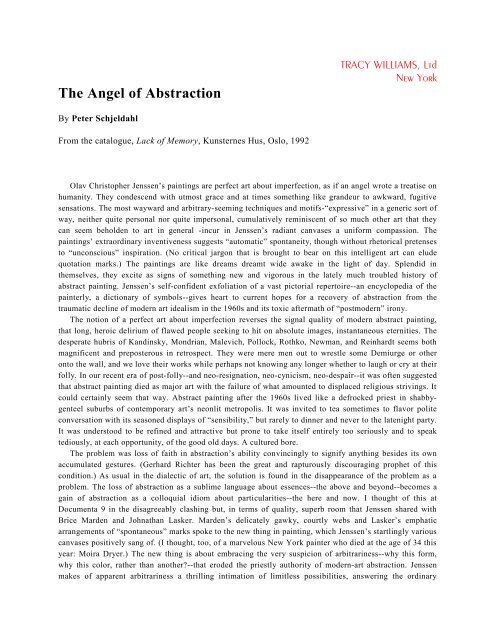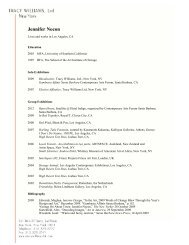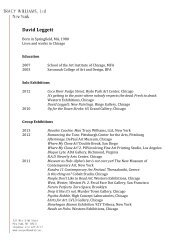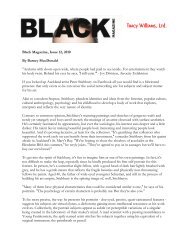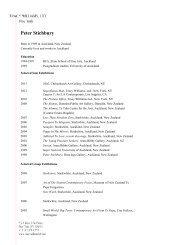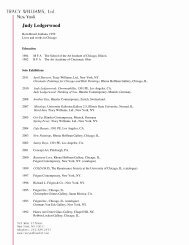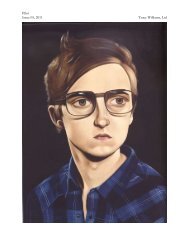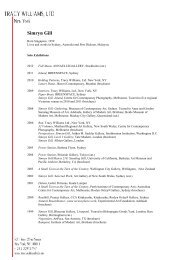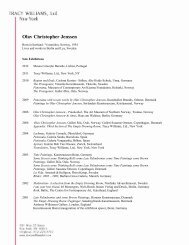Schjeldahl, Peter. "The Angel of Abstraction," - Tracy Williams, Ltd.
Schjeldahl, Peter. "The Angel of Abstraction," - Tracy Williams, Ltd.
Schjeldahl, Peter. "The Angel of Abstraction," - Tracy Williams, Ltd.
You also want an ePaper? Increase the reach of your titles
YUMPU automatically turns print PDFs into web optimized ePapers that Google loves.
<strong>The</strong> <strong>Angel</strong> <strong>of</strong> <strong>Abstraction</strong><br />
By <strong>Peter</strong> <strong>Schjeldahl</strong><br />
From the catalogue, Lack <strong>of</strong> Memory, Kunsternes Hus, Oslo, 1992<br />
TRACY WILLIAMS, <strong>Ltd</strong><br />
New York<br />
Olav Christopher Jenssen’s paintings are perfect art about imperfection, as if an angel wrote a treatise on<br />
humanity. <strong>The</strong>y condescend with utmost grace and at times something like grandeur to awkward, fugitive<br />
sensations. <strong>The</strong> most wayward and arbitrary-seeming techniques and motifs-“expressive” in a generic sort <strong>of</strong><br />
way, neither quite personal nor quite impersonal, cumulatively reminiscent <strong>of</strong> so much other art that they<br />
can seem beholden to art in general -incur in Jenssen’s radiant canvases a uniform compassion. <strong>The</strong><br />
paintings’ extraordinary inventiveness suggests “automatic” spontaneity, though without rhetorical pretenses<br />
to “unconscious” inspiration. (No critical jargon that is brought to bear on this intelligent art can elude<br />
quotation marks.) <strong>The</strong> paintings are like dreams dreamt wide awake in the light <strong>of</strong> day. Splendid in<br />
themselves, they excite as signs <strong>of</strong> something new and vigorous in the lately much troubled history <strong>of</strong><br />
abstract painting. Jenssen’s self-confident exfoliation <strong>of</strong> a vast pictorial repertoire--an encyclopedia <strong>of</strong> the<br />
painterly, a dictionary <strong>of</strong> symbols--gives heart to current hopes for a recovery <strong>of</strong> abstraction from the<br />
traumatic decline <strong>of</strong> modern art idealism in the 1960s and its toxic aftermath <strong>of</strong> “postmodern” irony.<br />
<strong>The</strong> notion <strong>of</strong> a perfect art about imperfection reverses the signal quality <strong>of</strong> modern abstract painting,<br />
that long, heroic delirium <strong>of</strong> flawed people seeking to hit on absolute images, instantaneous eternities. <strong>The</strong><br />
desperate hubris <strong>of</strong> Kandinsky, Mondrian, Malevich, Pollock, Rothko, Newman, and Reinhardt seems both<br />
magnificent and preposterous in retrospect. <strong>The</strong>y were mere men out to wrestle some Demiurge or other<br />
onto the wall, and we love their works while perhaps not knowing any longer whether to laugh or cry at their<br />
folly. In our recent era <strong>of</strong> post-folly--and neo-resignation, neo-cynicism, neo-despair--it was <strong>of</strong>ten suggested<br />
that abstract painting died as major art with the failure <strong>of</strong> what amounted to displaced religious strivings. It<br />
could certainly seem that way. Abstract painting after the 1960s lived like a defrocked priest in shabbygenteel<br />
suburbs <strong>of</strong> contemporary art’s neonlit metropolis. It was invited to tea sometimes to flavor polite<br />
conversation with its seasoned displays <strong>of</strong> “sensibility,” but rarely to dinner and never to the latenight party.<br />
It was understood to be refined and attractive but prone to take itself entirely too seriously and to speak<br />
tediously, at each opportunity, <strong>of</strong> the good old days. A cultured bore.<br />
<strong>The</strong> problem was loss <strong>of</strong> faith in abstraction’s ability convincingly to signify anything besides its own<br />
accumulated gestures. (Gerhard Richter has been the great and rapturously discouraging prophet <strong>of</strong> this<br />
condition.) As usual in the dialectic <strong>of</strong> art, the solution is found in the disappearance <strong>of</strong> the problem as a<br />
problem. <strong>The</strong> loss <strong>of</strong> abstraction as a sublime language about essences--the above and beyond--becomes a<br />
gain <strong>of</strong> abstraction as a colloquial idiom about particularities--the here and now. I thought <strong>of</strong> this at<br />
Documenta 9 in the disagreeably clashing but, in terms <strong>of</strong> quality, superb room that Jenssen shared with<br />
Brice Marden and Johnathan Lasker. Marden’s delicately gawky, courtly webs and Lasker’s emphatic<br />
arrangements <strong>of</strong> “spontaneous” marks spoke to the new thing in painting, which Jenssen’s startlingly various<br />
canvases positively sang <strong>of</strong>. (I thought, too, <strong>of</strong> a marvelous New York painter who died at the age <strong>of</strong> 34 this<br />
year: Moira Dryer.) <strong>The</strong> new thing is about embracing the very suspicion <strong>of</strong> arbitrariness--why this form,<br />
why this color, rather than another?--that eroded the priestly authority <strong>of</strong> modern-art abstraction. Jenssen<br />
makes <strong>of</strong> apparent arbitrariness a thrilling intimation <strong>of</strong> limitless possibilities, answering the ordinary
craving for experience <strong>of</strong> actual people whose eyes are connected to brains and hearts, to living bodies with<br />
desires and memories. <strong>The</strong> new thing--which is also an old thing, a sort <strong>of</strong> intimized Baroque in its explicit<br />
openness to viewers--is democratically sociable, declining to advertise transcendence. Rather, it treats<br />
sophistication <strong>of</strong> perception, thought, and feeling as a process with no goal, endless, enjoyable for its own<br />
sake, and not so much life-affirming as just life-recognizing. It is purely aestheticist-dandyish, even, in the<br />
Baudelairian way--but matter-<strong>of</strong>-factly, without aristocratic posturing or maudit hysteria.<br />
Jenssen’s paintings, never boring, are fit for any company while requiring none, as self-sufficient as the<br />
dandy whose eyes are always alertly amused and impossible to out-gaze. <strong>The</strong> presence <strong>of</strong> such a person in a<br />
room makes everyone present excitedly or uncomfortably aware <strong>of</strong> other rooms and places-- streets, palaces,<br />
dives--that constitute the unbroken domain <strong>of</strong> a citizen <strong>of</strong> the world. <strong>The</strong> dandy is ever utterly present in<br />
appearance and utterly absent in essence, telling the whole truth and nothing but the truth <strong>of</strong> a mask. He or<br />
she (there are female dandies in this fin de siecle, such as Cindy Sherman) “has style” not in the singular but<br />
in the plural, even the infinitely plural. He or she knows how to form from the mood <strong>of</strong> a moment an expression<br />
precisely suited to it, without regard for any other moment past or to come. <strong>The</strong> invisible consistency in<br />
Jenssen’s astonishing stylistic variability is a constant ratio <strong>of</strong> generosity and reserve: giving everything,<br />
withholding all. A balance. A perfection.<br />
A homeless kindness. I asked Jenssen what ideal worldly fate he would choose for his paintings when<br />
they leave his studio. He said, “I wish that one <strong>of</strong> them would be so expensive that I could afford to give all<br />
the rest to my friends.” So he is a pr<strong>of</strong>essional producer driven by love, making a peculiar sort <strong>of</strong> treasure<br />
for museums and private collections: gestures <strong>of</strong> love sidetracked and intercepted, ever in transit to a loved<br />
one never encountered. A telephone ringing in an empty room, and the ringing is the most beautiful music.<br />
I visited Jenssen in Berlin, where he has lived since 1982. Before that, he spent two years on New York’s<br />
Lower East Side during that neighborhood’s glory days <strong>of</strong> NeoExpressionist and graffiti-related painting and<br />
legendary nightlife. I found it interesting that this healthy-looking Norwegian, an affectionate family man,<br />
should have been drawn to two such raucously cosmopolitan, smoky, differently dangerous places. On the<br />
Lower East Side the dirty secrets <strong>of</strong> society, its greeds and cruelties, nakedly parade. And until 1989 Berlin<br />
was the capital <strong>of</strong> danger, where the malicious Wall called to mind a world clock always one tick from<br />
midnight and universal destruction. I myself live on the Lower East Side and have loved Berlin, and come to<br />
think <strong>of</strong> it I am Norwegian-blooded (via three generations in North Dakota) and a family man, too. So it may<br />
be no surprise that I find Jenssen mightily attractive and understand him hardly at all.<br />
Jenssen and I compared childhoods. Each <strong>of</strong> us had an entrepreneur father, whose schemes made the<br />
family situation unpredictable, and a relatively cultured mother (Jenssen’s an amateur painter). A big<br />
difference was in our respective early-childhood landscapes (such being, in my view, primary foundations <strong>of</strong><br />
human souls). Jenssen was happy in snowy mountains; I was melancholy on a prairie. I discovered that he<br />
had been a ski-jumper, and I teased him in Berlin that my whole interpretation <strong>of</strong> his work would be related<br />
to skijumping. <strong>The</strong> analogy would work, sort <strong>of</strong>. <strong>The</strong> idea <strong>of</strong> hurling oneself into l<strong>of</strong>ty emptiness while<br />
staying perfectly under control, and making an elegant figure there against the sky, is scarcely inconsistent<br />
with the effect <strong>of</strong> Jenssen’s paintings. But I rather suspect that skill in ski-jumping is a poor predicter,<br />
statistically, <strong>of</strong> artistic genius.<br />
Together we mourned bygone West Berlin--not the passing <strong>of</strong> the Wall, <strong>of</strong> course, but the loss <strong>of</strong> a<br />
cohesion and an energy that turn out to have been inextricable from the old tension. Today Berlin is a vast,<br />
drowsy blank for future generations to fill in and enliven. Drinking c<strong>of</strong>fee in Jenssen’s l<strong>of</strong>t and studying his<br />
powerfully tranquil canvases, I reflected that here was one artist who had made the most <strong>of</strong> the divided city.<br />
I decided that the pr<strong>of</strong>undity <strong>of</strong> Jenssen’s sophistication is rooted in an unillusioned knowledge <strong>of</strong> the<br />
terribleness <strong>of</strong> the world. Knowing the worst, one may go mad (not the way <strong>of</strong> a Norwegian ski-jumper) or<br />
seek to realize life’s best consolation under the circumstances, which will be a conditional and chastened,
even haunted happiness. Jenssen’s seraphically lyrical pictures are ballasted with a gravitas <strong>of</strong> history. <strong>The</strong>y<br />
will speak to the future <strong>of</strong> a particular epoch. Already they speak to various pasts.<br />
When I visited Berlin’s Dahlem museum with Jenssen, I was thunderstruck by the Rembrandt painting <strong>of</strong><br />
Jacob wrestling with the angel. (Jacob fought to detain the angel, demanding that she bless him.) With a<br />
touch <strong>of</strong> sublime comedy, Rembrandt’s angel, her countenance serene, pretends to resist the fiercely<br />
struggling man, while it is apparent to us that her strength is incalculably greater than his. She could break<br />
him in two. But she refrains from humiliating both his physical pride and his understanding <strong>of</strong> what he<br />
seeks. She shares with us the knowledge that by this pathetic act <strong>of</strong> violence with which he admits his<br />
human insufficiency, his need for the divine, Jacob has blessed himself. She cherishes him. Weak, vain<br />
comical humanity is cherished on high. <strong>The</strong> Rembrandt is perfect art about imperfection, and I felt an arc <strong>of</strong><br />
brotherly electricity leap from it to the Jenssens I viewed that morning.<br />
All <strong>of</strong> Jenssen’s recent paintings measure 275 cm by 255 cm, vertical enough to obviate landscape and<br />
the mural but not so vertical as to suggest a figure or a panel. <strong>The</strong> proportion’s slight lateral compression <strong>of</strong><br />
what at first glance appears a perfect square exercises an anti-gravity effect, as <strong>of</strong> a gentle updraft, on forms<br />
within the pictorial field. (Ross Bleckner is another painter who has used similar formats to a comparable<br />
though more obviously dramatic, “Gothic” effect.) In this field that feels at once generously roomy and<br />
neatly contained, things stay wherever Jenssen puts them, comfortably hovering.<br />
<strong>The</strong> paintings are executed in oils and acrylics with brushes and other implements (squirt bottles,<br />
scrapers, and whatnot). <strong>The</strong> canvases are painted both standing up on stretchers and, stretched over a floorhugging<br />
table strong enough to walk on, lying flat. (Seeing Jenssen standing on-or in--an unfinished<br />
painting, I observed that the 275-by-255 cm proportion is that <strong>of</strong> a small but habitable room, like a ship<br />
cabin.) Jenssen keeps several canvases in progress at once. He does not make preparatory drawings. It never<br />
occurs to him, he told me, that one <strong>of</strong> his paintings will fail and have to be rejected. Ideally the picture<br />
comes fast, with minimal effort. “I used to paint about nine layers. Now I like to separate out the layers, one<br />
to a canvas.” But <strong>of</strong>ten enough the mysterious criterion <strong>of</strong> sufficiency--in Jenssen’s case some exact pitch <strong>of</strong><br />
easeful eloquence--is not satisfied at once, and what results is the palimpsest <strong>of</strong> a tender struggle that arrives<br />
casually, as if by lucky accident, at pleasures <strong>of</strong> chiaroscuro and complexity.<br />
Jenssen is a colorist <strong>of</strong> subtle moods: slight irritablities, piquant irresolutions. He leans toward the<br />
secondaries--orange, green, purple--which are painting’s minor chords, the palette <strong>of</strong> Expressionism, but in<br />
muted, nonviolent relations. Most <strong>of</strong> all he favors orange, the most impossible <strong>of</strong> all hues employed in its<br />
densest pigmentations, its maximum orangeness (deep chrome and deep cadmium oranges). “Orange has a<br />
strange beauty and ugliness,” he says. It is anti-decorative (will not “go with” anything), as are his worrisome,<br />
vermouth-dry green (“sap green” from Rowney, a subliminal leitmotif in mixtures with white, ocher,<br />
and ultramarine) and hypersensitive pink (Rowney’s “flesh tint”). His colors are what painters call “fat,”<br />
with volumetric presence even in thin applications. <strong>The</strong>ir refusal to resolve into harmonies contributes to the<br />
delicate restlessness, the endless quiet excruciation, <strong>of</strong> Jenssen’s pictures.<br />
“Lack <strong>of</strong> Memory,” in English, is Jenssen’s general title for his current series <strong>of</strong> paintings. It is an<br />
unusual, telling locution, hard not to misread as the common phrase “loss <strong>of</strong> memory” that denotes one <strong>of</strong><br />
life’s most terrifying jeopardies. Losing memory is for subjective being what losing blood is for the body.<br />
But to lack memory? <strong>The</strong> condition suggested is strangely neutral and even conceivably positive. Aren’t our<br />
most wonderful moments, <strong>of</strong> sensual pleasure or mental abandonment, precisely passages <strong>of</strong> time in which<br />
memory (like its sister, anticipation) is lacking? At such moments, past and future telescope into the present,<br />
merging in presentness. (Moments that lacked memory become our lives’ loveliest memories.) Jenssen’s<br />
title is philosophically exact when applied to the art <strong>of</strong> painting. A painting does not remember anything. A<br />
painting is. Jenssen makes painting speak this truth about itself extravagantly, associating this aspect <strong>of</strong> its<br />
aesthetic nature to every manner <strong>of</strong> experience similarly construed. He activates the meaning <strong>of</strong>
“abstraction” as a physiological state--a state <strong>of</strong> which “lack <strong>of</strong> memory” is a good partial description.<br />
<strong>Abstraction</strong> is thus not just the genre but the subject / object, the quiddiry <strong>of</strong> Jenssen’s art. No wonder this<br />
art seems so grandly poised, so significant and important a development <strong>of</strong> abstract painting, whose capacity<br />
to suspend time it gloriously amplifies.<br />
From a ro<strong>of</strong>top in Berlin, Jenssen and I observed in the far distance an open-worked structure that<br />
evoked a diagram <strong>of</strong> a massive, eccentric church tower. It was odd and beautiful. Jenssen vaguely recalled<br />
having heard, though he could not be sure, that in fact it memorialized a destroyed church. What a lovely<br />
idea: to resurrect the contour <strong>of</strong> a lost building in a monumental drawing against the sky. I recalled for<br />
Jenssen that whenever I pass the site <strong>of</strong> a former apartment <strong>of</strong> mine on the Lower East Side, in a tenement<br />
long since burned down, I fancy a dotted outline in the air <strong>of</strong> those sixth-floor rooms. Driving around Berlin<br />
later, we made a detour to inspect the church-like structure. It turned out to be a banal framework supporting<br />
radio transmitters or something similar. It turned out to lack memory. And yet, after this disappointment, I<br />
decided that I liked the thing even better. It had made me dream wide awake in the light <strong>of</strong> day and in<br />
excellent company--a trifling but pure instance <strong>of</strong> the human struggle to find meaning in the world, a struggle<br />
which, seeking vainly to secure an angel’s blessing, blesses all <strong>of</strong> us.


